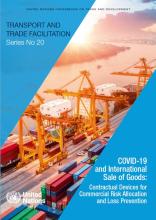
COVID-19 and International Sale of Goods: Contractual devices for commercial risk allocation and loss prevention
The impacts of the ongoing COVID-19 pandemic and related response measures have resulted in significant operational disruptions and delays across global networks, with important implications for the performance of international commercial contracts.
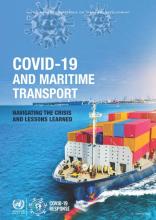
COVID-19 and Maritime Trasport: Navigating the Crisis and Lessons Learned
UNCTAD's report "Covid-19 and maritime transport: Navigating the crisis and lessons learned" describes how the COVID-19 pandemic shocked the global maritime transport system and some of the key effects on the sector. It highlights challenges arising from the disruption across ports and hinterland connections and examines response and mitigation measures implemented by various stakeholders. It sets out the key lessons that can inform and guide preparedness and resilience-building efforts in transport and logistics.
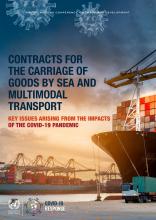
Contracts for the carriage of goods by sea and multimodal transport: Key issues arising from the impacts of the Covid-19 pandemic
Since the beginning of the COVID-19 pandemic, which was declared by the WHO on 11 March 2020, and in response to the emergence of new variants, countries have imposed, eased and re-imposed various restrictions on daily life, including for the entry and exit in ports. This has resulted in disruption and delay, with implications for the performance of commercial contracts for the carriage of goods.
COVID-19 and maritime transport: Impacts and Responses
The report sets out the UNCTAD assessment of the COVID-19 impacts on the maritime supply chain and challenges faced. It also identifies response measures introduced by relevant stakeholders, and the lessons learned in terms of resilience-building and implications for the maritime supply chain of the future.

COVID-19 implications for commercial contracts: International sale of goods on CIF and FOB terms
The ability to trade globally, through a seamless logistic network, moving goods across international boundaries, integrating engineering and technology from different parts of the world has been a fundamental element of the globalized trading system. Raw commodities travelling from one part of the world to be converted into plastic or metal components only to be shipped again to be manufactured and then again for assembling and distribution is something which traders and consumers alike take for granted.
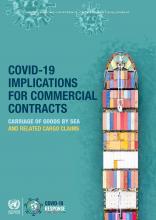
COVID-19 implications for commercial contracts: Carriage of goods by sea and related cargo claims
The smooth flow of international trade depends entirely on the transport chain: adequate and timely supplies to manufacturers and efficient capillary distribution chains are essential ingredients of any successful business model.
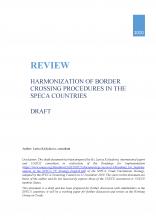
Review: Harmonization of border crossing procedures in SPECA Countries
The exponential growth of cross-border movements of goods often pushes States to develop more effective border management procedures implemented at border-crossing points (BCPs). Issues related to the facilitation of border-crossing procedures (time and documentary formalities) are of particular relevance to the countries participating in the United Nations Special Programme for the Economies of Central Asia (SPECA) (Afghanistan, Azerbaijan, Kazakhstan, Kyrgyzstan, Tajikistan, Turkmenistan and Uzbekistan), through which important transit corridors run between the global trading centres in East Asia and Europe.
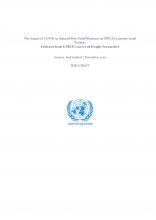
The Impact of COVID-19 Induced Non-Tariff Measures on SPECA Countries’ trade Patterns
This assessment was prepared pursuant the Governing Council of the United Nations Special Programme for the Economies of Central Asia (SPECA) - Afghanistan, Azerbaijan, Kazakhstan, Kyrgyzstan, Tajikistan, Turkmenistan and Uzbekistan. The decision stipulates preparing a study on regulatory and procedural barriers to trade in the sub-region, as per the “Concept Note for a Study on Regulatory and Procedural Barriers to Trade in the SPECA Subregion”.
The assessment also forms part of UNECE’s rapid COVID-19 response within the context of the United Nations Development Account project “Transport and Trade Connectivity in the Age of Pandemics: UN solutions for contactless, seamless and collaborative transport and trade”.